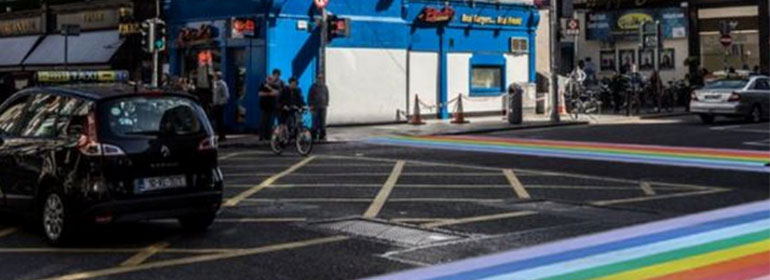The proposed Rainbow Walks in Dublin may be good for tourism and selfies, but they may tip the balance when it comes to queer overkill, says Rob Buchanan.
Dublin City Council is considering plans for the creation of ‘Rainbow Walks’ in some areas of Dublin city centre. They would basically be permanent Pride flag-coloured zebra crossings in the area that some queers already refer to as “the yellow brick road”. The Rainbow Walks are being touted to mark the first anniversary in May 2016 of our referendum win, but beyond simple commemoration there are multiple benefits from these proposed features.
Rainbow Walks would undoubtedly be elegant tourist attractions, which may spawn historic and cultural walking tours and maybe even merchandise, not to mention millions of social media photos. Installing them, especially in the Capel Street area, will arguably boost local business and contribute to the much-desired gentrification that has been an offshoot of gay neighbourhoods across the world.
A successful precedent for Rainbow Walks has been set in The Castro in San Francisco, the West Hollywood gaybourhood, in Tel Aviv and Sydney Australia. The Dublin Rainbow Walks would be outside Pantibar on Capel Street, at the corner of George’s Street and Dame Street, outside The George, and the final one at the junction of Parliament Street and Dame Street.

Objections on social media range from thinly-veiled homophobia to more practical concerns about the cost to Dublin City Council. Keyboard warriors are rolling out the usual tired rhetoric, grumbling about the cost to the tax payer. Shouldn’t we really be painting schools and hospitals instead of pansy pedestrian crossings? Well, the answer to that is that a number of multinational companies like Google and Facebook have already offered to fund the Walks, and besides the expense of putting down what’s essentially a multi-coloured zebra crossing is a drop in the ocean, considering the social and historic relevance and the income they could generate for the city.
Despite all this seemingly harmless positivity, I must admit I have mixed feelings about the Rainbow Walks proposal. There may be a big backlash. The fact is that many, even within the LGBT community, are experiencing fatigue at what they feel is a disproportionate saturation of LGBT culture in the Irish media. Even middle-of-the-road commentators and citizens are remarking on the gay headlines used by mainstream news outlets and businesses as click-bait.
We risk turning public attitudes sour. For example, responses by usually very supportive mates of mine to the publicity surrounding the film, The Queen of Ireland, have not been good. People were talking about overkill. There were articles in certain news outlets practically begging for a backlash. “Ten reasons why we aren’t sick of Panti” one headline proclaimed. While Panti is well able to withstand any slings and arrows, it’s the whole of the LGBT community who will feel the sting if the tide turns against us.
The danger isn’t that we will offend or annoy with a bit of paint on our streets. It is that by antagonising our supporters we are playing in to the hands of the real bigots and homophobes, who will be whipping up concerns that since we gave the gays equality we are now covering the city with their propaganda.
Those bigots haven’t gone away, you know. While they lost the marriage equality battle, they are still waiting to pounce, to play to the fears of the public, saying they were right all along. Ridiculous and unfounded as it is, we should take this threat very seriously because such attacks affect how we are seen and treated.
The acceptance and support the LGBT community received from Ireland at large this year was borne out of a sense of injustice. The Irish people were presented with the reality that LGBT citizens were being treated unequally and we are a people who hate unfairness. The bedrock of the Yes campaign was a message of equality, and while some strips of paint on the ground are hardly revolutionary, let’s ask ourselves if they are actually a step towards a kind of segregation.
The streets of Dublin belong to everyone, and when a communal area is marked proprietorially by one group, it can alienate others. How might we feel about painting Polish or Chinese flags on the roads and pavements of ethnic business areas? You and I might be delighted by the multicultural mix, but how about others who have lived on, and walked, and worked on those newly-defined streets for decades? Territorial marking in neighbourhoods in Northern Ireland can send a very clear message of who is welcome and who is not. And whilst to you and I rainbows painted on public pavements are a harmless decoration and celebration, they could be a subtle reaffirmation of difference to others.
Whilst I am 100 percent behind any progression of my community in Ireland, I know that it can only be genuine and lasting when it is based on true equality and integration. I welcome the Rainbow Walks, and if they are approved I look forward to seeing them, but I’m not naïve enough to believe that everyone in post-referendum Ireland is ready to go down the road to equality with us. We need time to build full, real acceptance.
The golden glow of the campaign and victory is dimming, and we are no longer the darling do-no-wrongs of old. Our detractors need to have their ammunition to justify discrimination. We can defend ourselves by showing how wrong they were to segregate us, not by doing it ourselves. Let’s proceed across the rainbow zebra crossing with caution.
© 2015 GCN (Gay Community News). All rights reserved.

comments. Please sign in to comment.